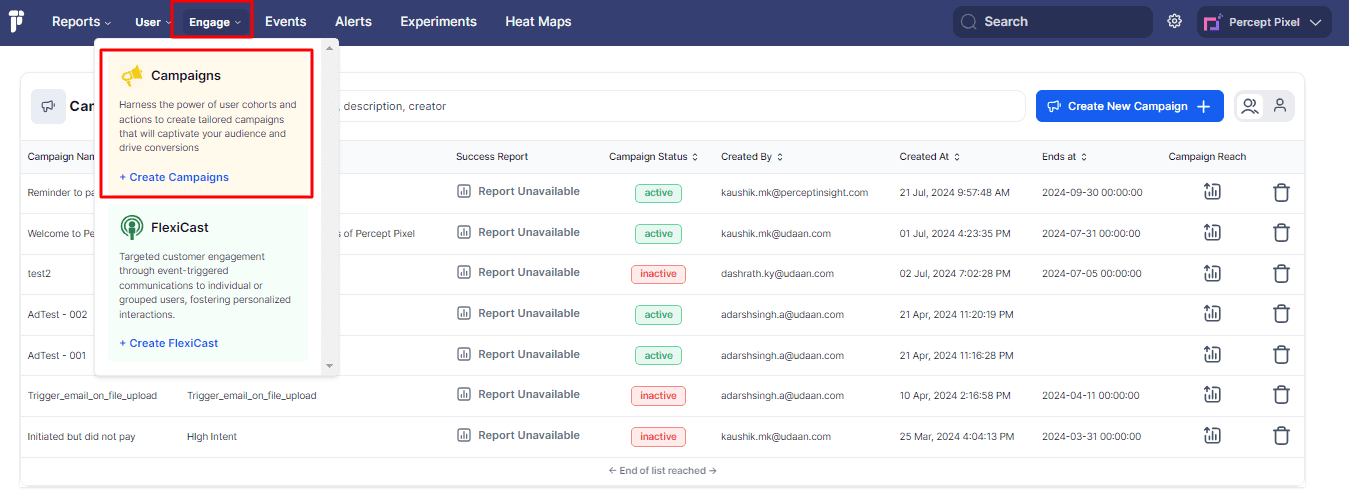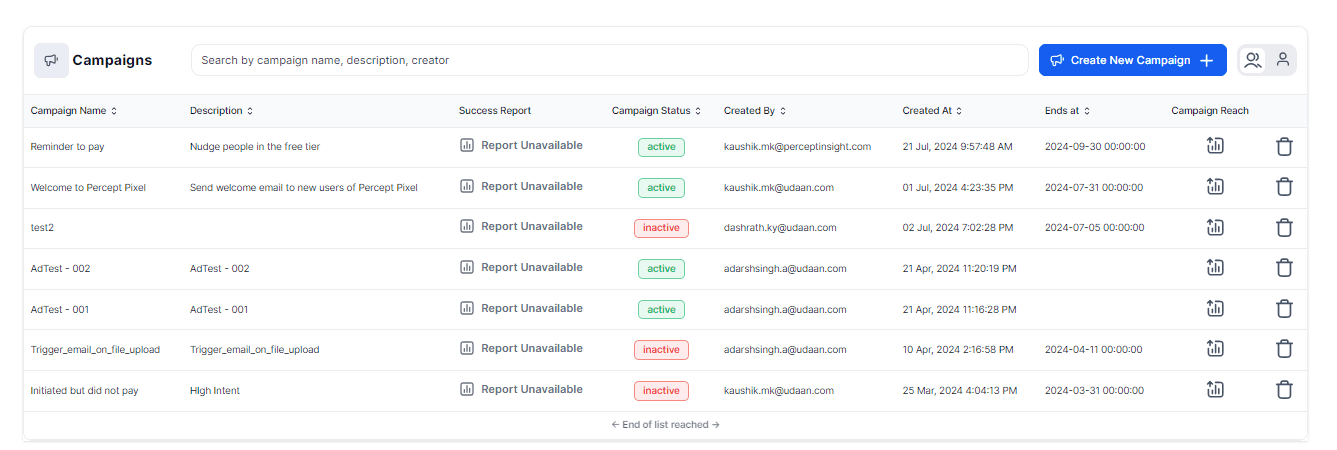Campaign and Flexicast
Create Campaign
Campaign Info
-
Visit the Engage Section: Navigate to the Engage section on Percept Insight.

-
Click on "Campaign": Open the campaign creation page.

Fill in the Campaign Info as below.
- Campaign Name: The title of your campaign.
- Description: Brief details about the campaign's purpose and goals.
- Max Engagements per Day: Set a daily limit for user engagements.
- End Date: Specify the campaign's end date.
- Success Metrics: Define the end goal to achieve.
![]()
Target Audience
User Segment:- Select user segments (cohorts) and specify the events performed or not performed within a certain timeframe. Cohorts can be static or dynamic, providing flexibility in targeting and analysis.
![]()
User Journey
The user journey refers to the series of interactions and experiences a user goes through while interacting with a product or service.
![]()
According to the above screenshot below is the detailed information about the user journey of "User does" & "User does not do"
A) As Soon as User Does
- APP OPEN
- First-time filter: This checkbox indicates that the condition should only apply to users opening the app for the first time.
- Filter: This button allows you to add additional filters to further narrow down the specific conditions for APP_OPEN.
- TRANSFORMATION_SAVED
- This condition specifies that the user must have saved a transformation.
- Filter: This button allows you to add further conditions to refine this event.
Additional user journey Conditions
There is an additional condition called "And/Or" logic meaning both conditions within this action group must be satisfied.
- TRANSFORMATION_BACKGROUND_REPLACED_IMAGE
This condition specifies that the user has replaced the background of an image during a transformation.
- TRANSFORMATION_NOT_SAVED
This condition specifies that the transformation was not saved.
Or: This logic indicates that either TRANSFORMATION_BACKGROUND_REPLACED_IMAGE or TRANSFORMATION_NOT_SAVED can be true for the additional condition to be satisfied**.**
B) And User does not do
This section sets conditions that must not be met for the action to be triggered.
- Action: TRANSFORMATION QUALITY MODIFIED
- This condition checks if the transformation quality has been modified.
- Within: The time frame for this condition is set to 5 minutes.
- Filter: Additional filters can be added to further refine this event.
Summary
The configuration shown in the screenshot specifies a complex set of conditions to be met within 10 minutes of the user performing an APP_OPEN action for the first time. The conditions include saving a transformation AND replacing the background of an image during the transformation, or not saving the transformation. Additionally, the condition that the transformation quality must not have been modified within 5 minutes.Once these conditions are met, an action will be triggered.
Select mode of communication
Choose the communication type, such as Push Notification, Email, SMS, WhatsApp, or Webhook, and provide necessary details like titles, descriptions, and target URLs.
![]()
- Push Notifications: Deliver real-time messages directly to users' devices.
- Email: Use emails for marketing and transactional purposes, tailored to user behavior and preferences.
- SMS: Send concise and impactful text messages for time-sensitive information.
- WhatsApp: Engage users on WhatsApp with templated messages.
- Webhooks: Trigger actions in other systems based on user events, facilitating real-time, cross-platform interactions.
Configure Reminders
Enable reminders to send notifications again if success metrics are not met.
![]()
Review and Launch:
Review all details through previews to ensure accuracy and save the campaign. By leveraging these features, businesses can create highly targeted and effective marketing campaigns that resonate with their audience and drive meaningful engagement.
Once the campaign is launched, the options below will help you get the status of the campaign.
Attribution and Reporting
- Success Reports: Provides real-time reporting on the performance of campaigns. Break down reports to analyze specific metrics and performance indicators, allowing for detailed insights and adjustments.
Steps to Access:
- Go to Engage
- Click on Campaigns or Flexicasts where the broadcast is created
- Click on the "View Report". This allows for detailed insights and adjustments by analyzing specific metrics and performance indicators.
![]()
The below attribution page will open where you can check the performance of the campaign/ flexicast. It tells you in granularity where the users went after receiving the engagement nudge
![]()
- Campaign Reach: Monitors the status of campaigns showing metrics such as "Initiated", "Sent", "Delivered", "Clicked", and "Failed." This helps in understanding the effectiveness of campaigns and identifying any issues in the delivery process. In the same Campaign, you can click on the Campaign reach and check all the statuses as mentioned in the screenshot below.
![]()
![]()
Further failure reports can be downloaded after clicking on the highlighted section and can see the reason behind the failure.
![]()
Create Flexicasts
Under Flexicasts, the same step as creating a campaign can be followed for creating the flexicast other than the below 2nd step.
Step 2: Trigger Condition in Flexicast
In this step, you will set the conditions that will trigger the Flexicast communication. Unlike the campaign creation process, Flexicast offers two types of trigger conditions: Event and Schedule/Adhoc.
1. Event
Event: This option allows you to trigger the communication based on specific user actions or events. For example, if you want to send a welcome message when a user opens the app for the first time, you would use the event trigger.
![]()
Event Trigger:
- Scenario: You want to send a push notification to users who open the app for the first time.
- Setup: Select "Event" as the trigger condition. Then, choose "APP_OPEN" as the event. You can add filters to narrow down the conditions, such as targeting only users from a specific location.
2. Schedule/Adhoc
![]()
Schedule/Adhoc: This option allows you to set a scheduled or ad-hoc trigger for the communication.
A. Adhoc
Adhoc: This option is used for sending communication immediately or at a specific start time, based on a one-time schedule.
![]()
Example:
- Scenario: You want to send an announcement about a flash sale to all users.
- Setup: Select "Schedule/Adhoc" as the trigger condition, then choose "Adhoc". You can choose to either send it now or schedule it to send at a specific start time.
B. Recurring
Recurring: This option is used for setting up communications that need to be sent on a regular basis.
![]()
Example:
- Scenario: You want to send a weekly newsletter to all users.
- Setup: Select "Schedule/Adhoc" as the trigger condition, then choose "Recurring". You will need to set the start date and the schedule frequency type.
- Start Date: The date when the recurring communication will begin.
- Schedule Frequency Type: The frequency with which the communication should be sent, such as daily, weekly, or monthly.
Once you have set the trigger conditions, you can proceed to the next steps, which involve setting the target audience and configuring communication details, similar to creating a campaign. This step is crucial for ensuring that the Flexicast is triggered appropriately based on real-time user actions or scheduled times, making your automated communication timely and relevant. By understanding these features and how to set them up, you can effectively manage and automate your communications, ensuring timely and relevant interactions with your audience.
Configure Communications:
1. WhatsApp:
WhatsApp is a messaging platform that allows users to send text messages, voice messages, images, and videos over the internet. It offers a convenient way to reach users on their mobile devices.
How It Works:
Step 1: Select WhatsApp template from the dropdown menu. Step 2: Check the preview to ensure the message format is correct. Step 3: Update any necessary details and save the campaign.
2. Push Notification:
Push notifications are messages that are sent directly to a user's device, typically via a mobile app or web browser. They are used to deliver real-time updates and engage users even when they're not actively using the app or website.
How It Works:
Step 1: Enter the appropriate title for the notification. Step 2: Craft a concise message for the notification. Step 3: Provide the URL of the image to be included in the notification (if applicable). Step 4: Specify the target URL users will be directed to upon tapping the notification (if applicable). Step 5: Review the preview to ensure all details are accurate. Step 6: Update and save the campaign.
3. Email:
Email is a widely used communication channel for sending messages, documents, and other content over the internet. It offers a versatile platform for both marketing and transactional communications.
How It Works:
Step 1: Enter the appropriate subject line for the email. Step 2: Craft the body of the email with relevant information and calls-to-action. Step 3: Attach any necessary files or documents. Step 4: Review the preview to ensure the email layout is visually appealing and all content is correctly formatted. Step 5: Update any necessary details and save the campaign.
4. SMS (Short Message Service):
SMS is a text messaging service that allows users to send short messages to other mobile devices. It provides a direct and immediate way to communicate with users, particularly for time-sensitive information.
How It Works:
Step 1: Select SMS template from the dropdown menu. Step 2: Review the preview for accuracy. Step 3: Update and save the campaign.
5. Webhook:
A webhook is a mechanism for automatically triggering actions in one system based on events that occur in another system. It enables real-time communication between different applications or services over the web.
How It Works:
Step 1: Enter the webhook URL where the data should be sent. Step 2: Save the webhook configuration.
Webhook URL Configuration
Tenants should first configure the webhook URL on their side with all the necessary requirements. The URL can be of any format according to the tenant's preference, as long as it meets the specifications provided. Once the URL is created with the required parameters, the tenant can proceed to use this URL to configure webhook communication on the PerceptInsight platform.
1. Endpoint Configuration
1.1 Set up a webhook endpoint on the tenant's system to accept POST requests. 1.2 Configure the endpoint URL according to the tenant's preferred format, ensuring it aligns with the webhook API contract requirements.
2. Request Body Configuration on Tenant Side
2.1 Ensure that the webhook endpoint on the tenant's side is configured to expect the following parameters in the request body:
itemId: A string representing the item ID. runId: A string representing the run ID. users: A list of users.
Webhook Format:
{
"endpoint": "/webhook",
"method": "POST",
"request": {
"metadata": {
"itemId": "string",
"runId": "string"
},
"users": [
{
"userId": "string",
"name": "string?",
"email": "string?"
},
{
"userId": "string",
"name": "string?",
"email": "string?"
}
]
},
"response": {
"status": "success", // or failure
"error": {
"message": "string",
"code": 400 // an HTTP status code
}
}
}
3. Security Measures
Implement appropriate security measures on the tenant's side to secure the webhook endpoint. This may include using HTTPS and implementing authentication mechanisms to prevent unauthorized access or data breaches.
4. Providing Configuration Details
Once the webhook URL is configured on the tenant's side, it can be utilized within the PerceptInsight platform for configuring campaigns or flexicasts to send webhook communications.
5. Summary
Using the provided webhook URL, configure webhook communication within the PerceptInSight platform for campaigns or flexicasts. This includes setting up the webhook endpoint URL, specifying the event types, and defining any additional parameters required for integration.
Conclusion:
User Engagement changes how businesses talk to customers, with a lively and responsive style. Businesses can easily use targeted campaigns because of the simple configuration process. Congratulations! You have now unlocked the full potential of User Engagement with Percept Insight. Haven't contacted us yet? Why wait? Visit our website here and book a demo today!